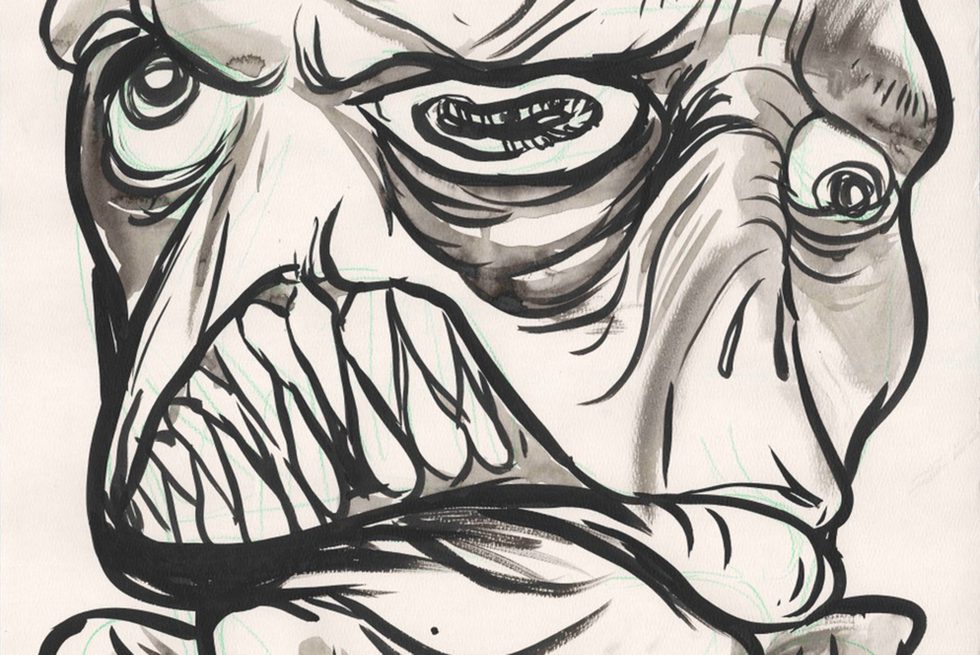The Woozle
From the Series: Time of Monsters
From the Series: Time of Monsters

Some monsters have never been observed, not even in fiction; especially in fiction, some question their very existence. Like dark matter in physics, they are monsters of the postulated kind, there to account for something else, something observable.

Whether or not it exists, the Woozle remains an enigmatic creature about which we know very little. Possibly a Hostile Animal, it roams the forests together with, as it might be, the Wizzle. Its natural habitat is the Hundred Acre Wood. It only appears as theory, when Piglet and Winnie-the-Pooh attribute to it the pawprints they trace. Following the tracks, circling around a group of trees, they discover additional sets of prints—smaller ones that, they conclude, could belong to a Wizzle. As the count of putative monsters continues to climb with each additional circuit they complete, Piglet abruptly recalls something that he “forgot to do yesterday and shan’t be able to do tomorrow . . . something that has to be done in the morning and, if possible, between the hours of what would you say the time was?” (Milne 1988, 41). Meanwhile Christopher Robin descends from the top of a tree, where he has been watching the two. More psychoanalyst than sovereign or Supreme Being, he only reports what he has observed, leaving the bear to contemplate his actions, to work through his symptom.
Granted, the fact that I see Woozles and Wizzles everywhere today owes something, no doubt, to my research interests—though, as this series shows, I am not alone. Mostly, what suggests their presence to me is not so much the so-called monsters that I study but rather something about their public presence and the political work they perform.
Like the monsters in our world, Woozles too keep proliferating. There’s always more of them, and always more kinds. They reproduce themselves, replicating their tracks, while summoning and mutating into other monsters. As we hunt for Woozles, as we stare at our traces and squeak with excitement, we too split open in a mirroring of that monster which, in turn, has always been a mirroring of us. A part of us that disavows the monster inside—let’s call it Pooh—would chase it to kill it, to expel it, to know it as other, as exterior. Another part—Piglet—suspects the truth and flees so as not to face the real horror. Could it be that, as we misrecognize our footprints, as we explain them with the monsters after which we hunt, we only leave more of them?
In fact, several different responses to our encounters with a suspicious pawprint are possible. We might name it (say, Woozle, or, populism), suggesting its radical difference as a monstrous being that we must chase and over which we shall have to prevail. Alternatively, and still recognizing the print as the Woozle’s, we could grant that it is not as different as we had perhaps hoped: at the very least, it too has paws. The menace, then, is that the Woozle stands too close and will contaminate us, devour us, make monsters out of us. But the story, I think, suggests yet a third possibility: the monster has always already been us. We gave birth to it; from us it received its paws. For that reason, too, it is real.
This encounter is an uncanny moment. Like the aging Sigmund Freud, who saw his own image reflected in the mirror of his train compartment bathroom as an intruder, we too encounter ourselves as other, as monstrous, as that which we would disavow. The hunt for the Woozle therefore splinters the self into a bear and a piglet: the psychotic self, overdetermined and overstimulated, oblivious to danger, chasing after monsters without quite deciding whether to fight or join them; and the neurotic self, worried about its integrity, anxiously inhabiting a monstrous world, a world full of monsters. The idea that we encounter ourselves, our footprints in the world, and that in them we confront a distorted mirroring of ourselves—or, if you will, that upon them we project and summon our nightmares in an infinite loop of repetition and fragmentation—this idea, to me, evokes the Woozle as the political monster of our time.
Of all the Woozles now roaming our metaphorical forests, I might illustrate this point with a New York Times profile of a white nationalist, with the headline “A Voice of Hate in America’s Heartland.” The portrait of Tony Hovater published in the Times painted him as a pleasant, normal guy with some regrettable worldviews rather than as a Nazi: a monster. Responses to the story were for the most part strongly critical, and many condemned what seemed like the normalization of white supremacy. While this disavowal of his ordinariness was concerned with the establishment of his radical monstrosity, such critiques also reveal a certain worry that the monster might be closer than we think or hope. In its response to these critiques, the Times suggested a different story: the monster is indeed all too similar to us and it is precisely its apparent normalcy, how close it comes to devouring us or turning us into a monster, that should alarm.
But the Woozle suggests a different dialectic of projection and disavowal, one in which we have always been the monster, even as we observe one monstrosity after another rise from our own footprints, even as we continue to externalize and misrecognize our own nightmares. Toward the end of the story, Pooh contemplates Christopher Robin’s words and seems to suspect the Woozle’s veracity. But if monsters, even those that dwell in the imagination of fictional characters, are real, then how long before we catch up with them?
Milne, A.A. 1988. Winnie-the-Pooh. New York: Dutton Children’s Books. Originally published in 1926.